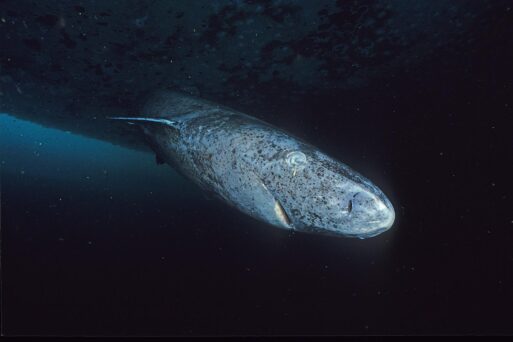
Credit: Henning1952 via Creative Commons
An international team of scientists has become the first to map the elusive Greenland shark’s genome, sequencing about 92% of its DNA. Having released their findings as a preprint — a scientific paper that has not yet gone through the peer-review process – the researchers are inviting more scientists to study the genome and conduct their own analysis, furthering our collective understanding of the shark’s DNA.
The Greenland shark (Somniosus microcephalus) is the longest-lived vertebrate known, with an estimated lifespan of around 400 years. The hope is that the new genome map can unlock the secrets behind their impressive lifespan, and perhaps provide mechanisms for lengthening our own life expectancy.
Greenland Sharks
Greenland sharks live in the deep, cold waters of the North Atlantic and Arctic oceans, and are the only sharks to withstand the freezing temperatures year-round. Because of these preferences, researchers have only recently been able to collect scientific data on the elusive species. In fact, their incredible lifespan had been estimated before, but it wasn’t until 2016 that a study conducted by Copenhagen marine biologists was able to use radiocarbon dating to establish that some of the oldest living specimens are over 500 years old.
What they do know is that Greenland sharks have an extremely slow growth rate of less than 1 centimeter a year, with a matching sluggish metabolism as well. Because of their unhurried approach to life, these sharks don’t even reach sexual maturity until they’re over a century old.
The New Genome Sequencing Study
Dr. Steve Hoffman, one of the senior authors of the new research on the Greenland shark and a computational biologist at the Leibniz Institute on Aging in Germany, hopes that the team’s genome map can be “some kind of tool, if you will, that allows us – and of course, other researchers – to look into these molecular mechanisms of longevity.”
Most notably, in this study the team found the shark’s genome to be extraordinarily large, twice as long as a human’s and bigger than any other shark genome sequenced to date, according to an article on the study by CNN Science. One possible explanation might come down to the shark’s extraordinary ability to repair its DNA, a trait that has commonly been seen in other species with exceptional lifepans, like the naked mole rat, and certain species of tortoises.

Professor Arne Sahn, one of the study’s lead authors
Credit:FLI / Evelyn Kästner
They also found that the Greenland shark is unique in that more than 70% of its genome is made up of jumping genes, which can move within the DNA sequence by duplicating themselves, sometimes creating mutations. In many species, these duplications are referred to as “genetic parasites” due to their potential harmful effects, including genetic diseases such as cancer. But in the Greenland shark, the genes that repair DNA have been acting as jumping genes, distributing themselves into the genome and slowing down the aging process by fixing damaged DNA. Lead author Dr. Arne Sahm, a bioinformatician and junior professor at Ruhr University Bochum in Germany, says that as a result, “the detrimental effect of these transposable elements (jumping genes) is not only canceled out, but maybe even reversed so that the genome integrity is even better.”
What This Could Mean for Us
Although much more research will be necessary, the findings of this new study support what some scientists already know about the aging process. Previous studies, like the one conducted in 2021 by Holtze et al., have found that “longevity-associated genes mainly relate to DNA repair, mitochondrial balance/mitochondrial biogenesis, immune system functions, oxidative stress resistance, and telomere maintenance.” Some earlier research has even been able to extend the lifespan of certain short-lived species, such as flies and mice, by using genetic modifications.
By learning more about the Greenland shark’s unique DNA repair technique, scientists can begin to study how the trait contributes to other age-delaying factors (such as tumor suppression), as well as potential effects on the cells of other species, including our own. “If we really want to increase the human lifespan significantly, or maybe even better, to extend the percentage of our life (in which) we are really healthy and fit and can do things […] it’s good to look at the tricks of very long-lived animals,” Sahm said.

 Greenland Sharks May Offer Clues to Extending Human Lifespans
Greenland Sharks May Offer Clues to Extending Human Lifespans


 How Dare You Die Now!
How Dare You Die Now!
 Debating Medical Aid in Dying
Debating Medical Aid in Dying
 “Help Me, Helen”
“Help Me, Helen”














